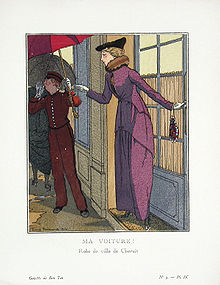Graphic arts
Graphic art is a category of fine art which covers a broad range of visual artistic expression, typically two-dimensional, i.e. produced on a flat surface. The term usually refers to the arts that rely more on line or tone than on colour, especially drawing and the various forms of engraving; it is sometimes understood to refer specifically to printmaking processes, such as line engraving, aquatint, drypoint, etching, mezzotint, monotype, lithography, and screen printing (silk-screen, serigraphy). Graphic art further includes calligraphy, photography, painting, typography, computer graphics, and bindery. It also encompasses drawn plans and layouts for interior and architectural designs.
Art Deco
 Main article: Art Deco
Main article: Art Deco
Art Deco is an eclectic artistic and design style which had its origins in Paris in the first decades of the 20th century. The style originated in the 1920s and continued to be employed until after World War II. The term "art deco" first saw wide use after an exhibition in 1966, referring to the 1925 Exposition Internationale des Arts Décoratifs et Industriels Modernes that was the culmination of high-end style moderne in Paris. Led by the best designers in the decorative arts such as fashion, and interior design, Art Deco affected all areas of design throughout the 1920s and 1930s, including architecture and industrial design, as well as the visual arts such as painting, the graphic arts and film. At the time, this style was seen as elegant, glamorous, functional and modern.
History
Throughout history, technological inventions have shaped the development of graphic art. In 2500 BC, the Egyptians used graphic symbols to communicate their thoughts in a written form known as hieroglyphics. The Egyptians wrote and illustrated narratives on rolls of papyrus to share the stories and art with others.
During the Middle Ages, scribes manually copied each individual page of manuscripts to maintain their sacred teachings. The scribes would leave marked sections of the page available for artists to insert drawings and decorations. Using art alongside the carefully lettered text enhanced the religious reading experience.
Johannes Gutenberg invented an improved movable type mechanical device known as the printing press in 1450, the first outside of Asia. His printing press facilitated the mass-production of text and graphic art and eventually, replaced manual transcriptions altogether.
Again during the Renaissance years, graphic art in the form of printing played a major role in the spread of classical learning in Europe. Within these manuscripts, book designers focused heavily on typeface.
Due to the development of larger fonts during the Industrial Revolution, posters became a popular form of graphic art used to communicate the latest information as well as to advertise the latest products and services.
The invention and popularity of film and television changed graphic art through the additional aspect of motion as advertising agencies attempted to use kinetics to their advantage.
The next major change in graphic arts came when the personal computer was invented in the twentieth century. Powerful computer software enables artists to manipulate images in a much faster and simpler way than the skills of board artists prior to the 1990s. With quick calculations, computers easily recolor, scale, rotate, and rearrange images if the programs are known.
The scientific investigations into legibility has influenced such things as the design of street signs. New York City is in the process of changing out all of its street signs bearing all capital letters for replacement with signs bearing only upper and lower case letters. They estimate that the increased legibility will facilitate way-finding and reduce crashes and injuries significantly.
Careers
One of the most common career paths for a graphic artist today is web design. With the popularity of the World Wide Web, the demand for web designers is immense. Graphic artists use their creativity with layouts, typography, and logos to market the products or services of the client’s business. In addition to creating graphical designs, graphic artists also need to understand hypertext, web programming, and web page maintenance in order to successfully create a web page. The responsibility for effective communication also falls under the auspices of the graphic designer.
Chat rooms • What links here • Copyright info • Contact information • Category:Root
